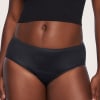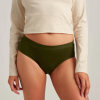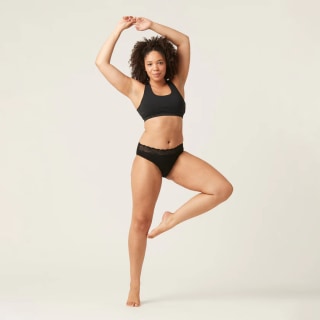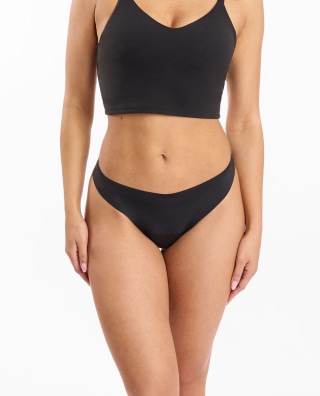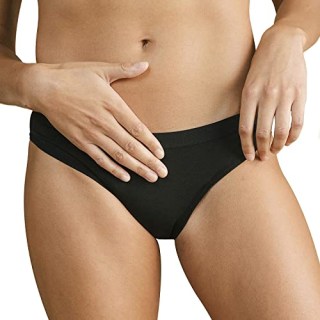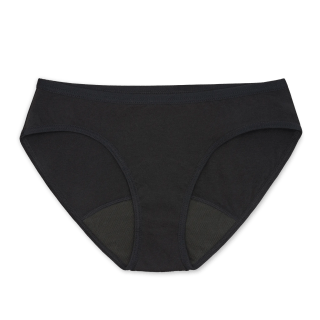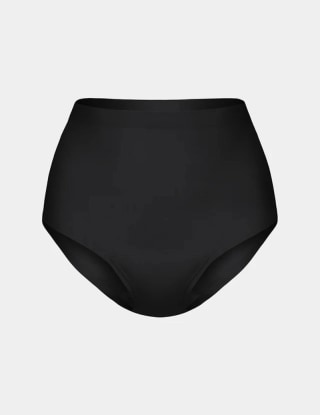While pads and tampons have reigned supreme since around the 1930s, alternative menstrual products like period underwear, menstrual cups and discs have been popping up more and more in the wellness space. “As folks begin to talk more openly and more often about menstruation and menstrual health, they share options beyond what they assume to be the one and only method of care — typically commercial pads and tampons,” says Chris Bobel, professor of women’s, gender and sexuality studies at the University of Massachusetts, Boston.
Period underwear is reusable, designed to handle the different flows throughout your period and helps people who menstruate move away from disposable products. Plus, it can be a worry-free backup to a tampon, cup or disc, or take their place altogether.
To better understand how period underwear works (and whether it’s safe to use), I spoke to gynecologists, women’s health experts and environmental chemists about its benefits, potential safety concerns and how to use it. I also gathered expert-recommended and NBC Select staff-tested options to shop.
How I picked the best period underwear
These are the factors experts recommend keeping in mind when shopping for period underwear:
- Absorbency level: There are three main absorbency levels for period underwear: light, moderate and high. Most period brands determine the absorbency level by how it compares to regular tampons, which experts say typically hold up to five milliliters of blood each (though this varies by brand). Some of the most absorbent period underwear on the market can hold more than five regular tampons’ worth of blood, says Dr. Carolyn Moyers, a board-certified OB/GYN and founder of Sky Women’s Health. Based on my experts’ guidance, I consider light absorbency to equal one to two tampons, medium absorbency to equal three to four tampons and high absorbency to equal five or more tampons.
- Material: Look for moisture-wicking fabrics like nylon and polyester, which absorb wetness and dry quickly, experts say.
- Washable: Consider period underwear that’s machine-washable, which makes it easier to clean and reuse.
- Fit: Period underwear comes in a variety of styles that mimic your typical underwear you would wear everyday, including full-coverage, cheeky, thongs and boxers. Consider the style that fits best for you and your lifestyle.
Want more from NBC Select? Sign up for our newsletter, The Selection, and shop smarter.
The best period underwear of 2025
Below, I rounded up the best period underwear and indicated each underwear’s absorbency level (either based on number of regular tampons, volume in milliliters, or both). Each of the following underwear is reusable and machine-washable.
Knix is a favorite brand among our NBC Select editors — we’ve tested both its period underwear and wireless bras. I use the light absorbency of this bikini-style underwear toward the end of my period (when my flow is the lightest), and it’s entirely leak-resistant, which gives me total peace of mind both throughout the day and at night while I sleep.
It’s also a favorite of NBC Select reporter Zoe Malin, who says these are one of the most comfortable pairs she’s tried. “I’ll admit that I was very hesitant about period underwear for years, but these really changed my mind. Why? Because they don’t feel like I’m wearing a diaper (if you know you know),” she says. “Other period underwear I’ve tried are thick and bulky. but these aren’t at all. They look super smooth under looser pants and shorts, and are very comfortable.”
The underwear is available in four absorbency levels, plus an everyday, non-absorbent pair. Every pair of Knix period underwear comes with an absorbency guide that tells you exactly how many teaspoons it absorbs and the equivalent number of pads, tampons and menstrual cups.
When it comes to period underwear, it can be hard to find a style that protects against leaks and makes you feel attractive. Fortunately, ModiBodi has period underwear in several sexy cuts and cute patterns that can help you look and feel your best. This Sensual Hi-Waist Bikini is one of those pairs, which has a 4.8-star average rating from more than 700 reviews on its site. This bikini-style underwear sits right at the hip, has a high-leg cut and a soft waistband with lace trim. It comes in three absorbency levels: light (about the same absorbency as up to four tampons), moderate (up to six tampons) and super (up to 10 tampons). The bikini-style underwear is also made with a stain-, odor- and bacteria-resistant lining, according to the brand.
Proof is another NBC Select editor-favorite brand, and it designs underwear for different needs, like postpartum, workout and maternity. If you have a lighter flow and want a more undetectable style, Proof’s Leakproof Thong has the absorbency of about one tampon and helps with light leaks and erases panty lines, according to the brand. Made from a breathable microfiber fabric and with a low-rise silhouette, the underwear is primarily meant for spotting, sweat and other discharge, so it’s best to use it in conjunction with a tampon, according to Proof. It has a 4.5-star average rating from over 50 reviews at the brand’s site.
Thinx is one of the more well-known period underwear brands with lines designed for different ages and lifestyles, including options for tweens and teens, as well as bladder leaks. (Thinx settled a class-action lawsuit in 2022 claiming the brand’s underwear contains harmful chemicals. Thinx denies these claims and admits no guilt or wrongdoing. We go more in-depth about this below.)
NBC Select SEO editor Nikki Brown says Thinx was her introduction into period underwear. “It’s very supportive if you have hips and curves. In my experience, these didn’t ride up my backside and cause leakage,” she says. Made from stretchy and breathable nylon and elastane, this underwear prevents leakage for up to 12 hours, according to the brand. All of the brand’s period underwear can absorb up to 12 regular tampons’ worth of blood, the highest on this list. Thinx has five styles of period underwear to choose from: hiphugger, brief, hi-waist, shorts and bikini.
Though Saalt, which is one of our favorite women-owned brands, is best known for its popular menstrual cups and discs, it also has a leak-resistant period underwear line called Saalt Wear, which includes styles like bikinis, thongs, boyshorts, hipsters and briefs designed to absorb periods, bladder leaks and more. The Leakproof Comfort Brief, which has a 4.5-star average rating from over 1,700 reviews at Saalt, can absorb as much as eight regular tampons’ worth of blood, according to the brand. Plus, this pair is made from soft Tencel Modal fabric, has a mid-rise fit and stretchy elastane waistband.
If you’re looking for more coverage and support, Aisle’s Boost Boxer has a high-rise design, a thick waistband and an absorbency that matches up to four tampons. It comes with a removable booster that you can tuck into the ends of the gusset for an additional four tampons of protection (or a total absorbency of about eight tampons) for heavier flow days, according to the brand. The underwear has over a 4.5-star average rating from over 800 reviews at Aisle. In addition to period underwear, Aisle also has liners, pads and menstrual cups.
Cora makes some of our favorite expert-recommended menstrual cups, and its period underwear is just as good — this comfortable, stretchy bikini style that can absorb the same as three regular tampons, according to the brand. The brand recommends this underwear, which has a 4.3-star average rating from over 200 reviews at Cora, for moderate flow days to pair with a pad, cup or disc, and its Sleep Short (which holds up to six tampons) for heavier flows. The underwear is made with a moisture-wicking core and elastane for stretch, plus it’s available in packs of one or three.
Rael, one of our favorite AAPI-owned brands, has three underwear styles: bikini that can absorb as much as three tampons’ worth of blood, plus high-waisted and boyshort styles that both absorb the same as up to five tampons, according to the brand. Meant to look and feel like everyday underwear, it’s made with four layers, including one with breathable cotton and another that’s meant to protect against moisture and odors, according to Rael. The brand recommends changing it after 5-8 hours of use.
In addition to period underwear, including a disposable pair for heavy flows and postpartum, Rael carries its own collection of menstrual cups, pads, tampons and panty liners. Rael’s period underwear has a 4.1-star average rating from over 100 reviews on Amazon.
NBC Select editorial operations associate Jem Alabi is a fan of this overnight pair from Proof. “These are really great, and in my experience, they are good to go in the wash after a quick hand rinse,” she says. “They fit snugly, but are not restricting, which is super important for period underwear.” This brief-style underwear absorbs the same as up to nine tampons and has a comfortable, full coverage fit. The underwear also has a super thin lining, which makes it look inconspicuous underneath clothing, says Alabi.
Another option from Knix, the brand’s Super Leakproof High Rise is among its most popular pairs. Great for heavy flow days, this pair absorbs up to four super tampons’ worth of liquid, and it has a long gusset (the liner that’s built into the crotch section of the underwear) that extends from the front all the way to the back waistband, which is meant to provide the most coverage possible, according to Knix. In terms of fit, the underwear has a snug, mid-rise silhouette. If you want a similar fit with even more coverage, consider the brand’s Ultra Leakproof Zones+ High Rise, which absorbs the same as up to nine super tampons.
The Period Company makes period underwear and reusable pads. Among the brand’s most popular offerings, this high-waisted pair is made from soft organic cotton and stretchy spandex, and it can hold up to nine tampons’ worth of liquid, according to the brand. The underwear is leak-resistant for an average of 8 hours, which makes it great for heavy overnight flows, according to the brand. Brown says these are a great budget-friendly option, but keep in mind the material doesn’t hold up as well as other options. “If you don’t wash them properly, they wear out fast,” says Brown. The brand also has a bikini style with a lower rise and full coverage boxer shorts.
How to shop for period underwear
Period underwear is usually offered in three absorption levels for light, moderate or heavy flows. They can hold as much as (and sometimes more than) five regular tampons’ worth of blood for heavier or overnight flows, which is more than most pads can hold, says Moyers. Light absorbency styles can hold about as much as a typical pantyliner.
Just like with pads or tampons, you should pick period underwear based on your specific flow. Try out different absorbencies to get comfortable wearing them and to see how each feels with your body and flow, experts say. If you have a heavier flow, you may want to use it in combination with other period products like a tampon or menstrual cup for extra protection and to avoid leaks, says Dr. Taraneh Shirazien, a board-certified gynecologist at NYU Langone and director of the Center for Fibroid Care.
Is period underwear safe?
When we initially reported this piece, experts told us that period underwear is safe to use. That advice remains true, despite a 2020 report in Sierra Club Magazine that says testing found Thinx period underwear (one of which we recommend in this guide), contains potentially harmful chemicals, namely harperfluoroalkyl and polyfluoroalkyl substances or PFAS . The report spurred a class-action lawsuit alleging that Thinx inaccurately marketed its products as “safe, healthy and sustainable” and “free of harmful chemicals.” While Thinx privately settled the case in November, it denies the allegations and admits no guilt or wrongdoing.
PFAS have been around for decades. They’re used in the manufacturing of consumer products due to their stain-, grease- and water-resistance properties, and they’re commonly found in nonstick cookware, water-repellent gear and apparel, firefighting foam and stain-resistant fabrics and carpets.
“PFAS is integrated into the construction of the fibers so it can protect them and make them more water-resistant,” says environmental chemist Ilias Kavouras, who is the assistant dean for academic affairs at the University of Memphis School of Public Health.
In fact, PFAS are almost everywhere in our environments: “We have a lot of evidence showing that dust particles in your home, contaminated water and food packaging are all major routes of PFAS exposure, says Linda Kahn, assistant professor in the Division of Environmental Pediatrics at the NYU Grossman School of Medicine. Period underwear brands are often capable of using alternatives to PFAS, but the water- and stain-resistance may not be as effective, says Kahn. And some manufacturers may not even be aware they’re incorporating PFAS in their products because it can be the raw materials they use that have them, she says.
Exposure to PFAS from using period underwear, which is through the skin, has limited data. “Nobody has really quantified the percent [of PFAS] that’s absorbed dermally, but there’s some indication that it’s possible,” says Kahn.
But it doesn’t hurt to limit our exposure to PFAS, experts say. “We are constantly exposed to PFAS in our everyday lives, so how much extra should people be concerned about period underwear versus lipstick, dietary exposure or water-resistant clothing? Is it worse than anything else you’re doing? Probably not,” says Kahn. “But ideally, one should try not to expose themselves through any means to the degree that we have any control over it.”
More about the Thinx class-action settlement
A complaint filed in May 2022 alleged that Thinx had deceptively marketed its products as a “safe, healthy and sustainable choice for women that “is free of harmful chemicals,” when the presence of chemicals like PFAS and nanoparticles in some samples of the brand’s underwear “are a safety hazard to the female body and the environment.”
Thinx denies all allegations — emphasizing that the settlement was not an admission of guilt.
“Consumer health and product safety are top priorities for Thinx, and we stand by the quality, efficacy and safety of our products,” Thinx said in a statement to NBC Select. “PFAS is not included in our product design and we continue to take measures to help ensure these substances are not added to our products.”
As part of the settlement, Thinx agreed to reimburse up to $5 million to customers who purchased its underwear between Nov. 12, 2016 and Nov. 28, 2022.
Meet our experts
At NBC Select, we work with experts who have specialized knowledge and authority based on relevant training and/or experience. We also take steps to ensure that all expert advice and recommendations are made independently and with no undisclosed financial conflicts of interest.
- Chris Bobel is a professor of women’s, gender, and sexuality studies at the University of Massachusetts, Boston.
- Dr. Andrea Zuckerman is the chief of pediatric and adolescent gynecology and vice chair of gynecology at Tufts Medical Center. She is also an associate professor at Tufts University School of Medicine.
- Dr. Carolyn Moyers is a board-certified OB/GYN and founder of Sky Women’s Health.
- Dr. Taraneh Shirazien is a board-certified gynecologist at NYU Langone and director of the Center for Fibroid Care. She is also the director of the Division of Global Women’s Health at NYU Langone Health.
- Dr. Tina O’Shea is a board-certified OB/GYN and an assistant professor in the department of obstetrics and gynecology at the University of Florida College of Medicine.
- Dr. Lauren Naliboff is a board-certified OB/GYN and assistant professor in the department of obstetrics, gynecology and reproductive health at Rutgers New Jersey Medical School.
- Ilias Kavouras is a chemist and professor and assistant dean for academic affairs at the University of Memphis School of Public Health.
- Linda Kahn is an assistant professor in the Division of Environmental Pediatrics at the NYU Grossman School of Medicine.
Why trust NBC Select?
I’m an updates editor at NBC Select who has covered beauty, wellness and personal care since 2021. For this article, I spoke to six gynecologists and women’s health experts about how to shop for period underwear, the benefits and drawbacks of these menstrual care products and whether they’re safe to use. I also compiled highly rated options based on experts’ advice and ones NBC Select editors have tried and loved.
Catch up on NBC Select’s in-depth coverage of tech and tools, wellness and more, and follow us on Facebook, Instagram, Twitter and TikTok to stay up to date.




